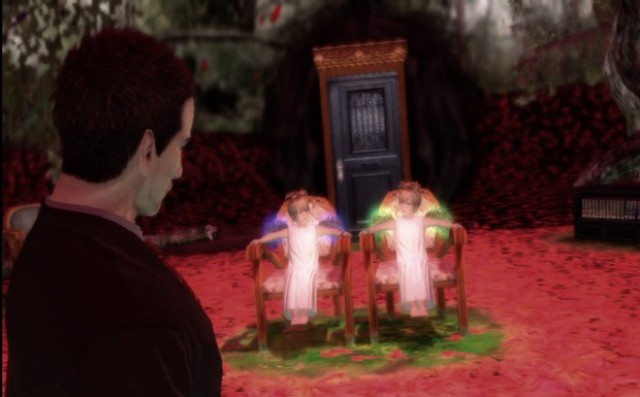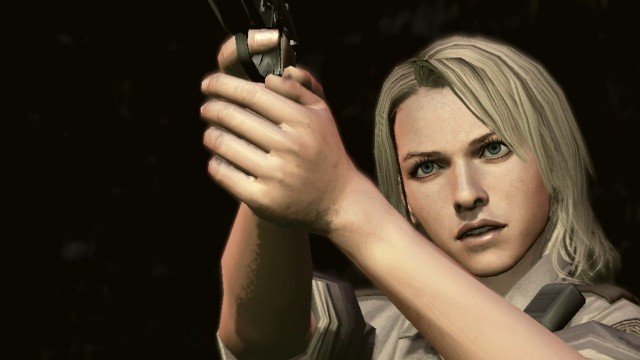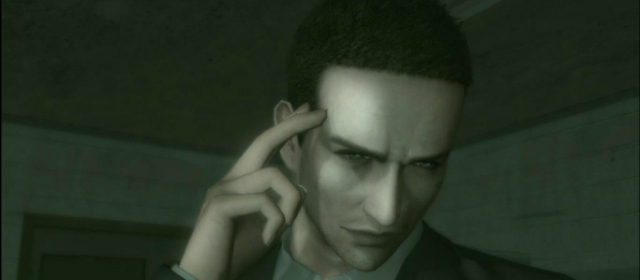Name: Francis “York” Morgan
Game: Deadly Promotion (2010)
Species: Human
In his own words: “Do you feel it, Zach? My coffee warned me about it.”
As is becoming standard for episodes of Character Select, this article is full of enormous spoilers. Play Deadly Premonition, then read it. You have been warned.
Deadly Premonition is a metafictional masterpiece masquerading as a low-budget curiosity. Visually striking for all the wrong reasons, the game polarised critics in the extreme when it was released in 2010, with review scores famously ranging from a 2 from IGN (“awful in nearly every way”) to a 10 from Destructoid (“pretty close to perfect”). Since then, the notoriety it earned through its low production values and questionable gameplay design have given way to almost universal acclaim and recognition as a cult classic.
This is largely down to its story, a bizarre supernatural murder mystery set against a backdrop of small-town eccentricity that uses explicit references to the oeuvre of surrealist director David Lynch both to add depth to its plot and give the player a clue that maybe all is not as it seems. The story of an FBI agent sent to a small town to investigate a murder would always draw passing comparisons to Twin Peaks, but Deadly Premonition contains such a vast number of explicit references to the beloved television series (an extensive list can be found here) that it bears closer analysis. While there were a few critics who simply declared it a ripoff or a cheap attempt to make “Twin Peaks: The Game”, that’s a rather reductive approach that fails to appreciate how much more interesting Deadly Premonition is when viewed through the Lynchian prism that so clearly influenced it.

But let’s back up a bit. The protagonist of Deadly Premonition is Francis “York” Morgan, an FBI agent sent to the sleepy town of Greenvale to investigate the murder of young Anna Graham, found dead, Laura Palmer-style, in mysterious circumstances. The player controls York as they would any other video game protagonist, directing him around the world and making him interact with it, but they’re not York. No, the player is actually Zach, York’s invisible friend, a man who apparently lives in York’s head and to whom York talks throughout the game with scant regard for the anyone’s perception of his sanity; or lack thereof.
It’s “Zach” whom York asks for help during action sequences, “Zach” whom he credits with figuring out tricky aspects of the case, and all the while the residents of Greenvale (with the eventual exception of love interest Emily) simply look upon him with bemusement or suspicion. The player knows York’s breaking the fourth wall, acknowledging their existence, but no-one in the game seems to realise it.
Deadly Premonition is not the first game to involve the player in narrative as well as gameplay. More games than you’d think do this during their tutorial sequences; Lara Croft tells you to “press the jump button” when you’re guiding her around her gym, for example. Other games make witty nods to the person wielding the controller too, the story of Prince of Persia: The Sands of Time is told by its protagonist after the events take place, so when player ineptitude results in the hero’s death, the GAME OVER screen prompts him to mutter “wait, that’s not how it happened”. April, the protagonist of point-and-click adventure The Longest Journey, will respond to being clicked on by musing “I almost feel as if there’s someone watching me…”.
Some games go further, using player preconceptions about interactivity and control to add depth to their narratives. The Assassin’s Creed series uses a virtual reality suite as a central plot device, meaning that the player’s “real life” act of controlling the dexterous assassin is extremely similar to that of the game’s “real” protagonist, lying still within the Animus and reliving his ancestor’s memories. Similarly, BioShock’s famous “Would you kindly?” twist exploits the player’s self-deluding sense of autonomy within the game world.

However, while these games either break the fourth wall or use it as a metaphor, Deadly Premonition completely circumnavigates it, making the player a cast member in its tale of small town secrets. More interactive theatre, if you will, than Brechtian Epic. As the Greenvale mystery deepens, York reveals that he met Zach when he was a child, the latter having arrived to comfort the former following his mother’s murder at the hands of his father. According to York, Zach has been “with” him ever since, offering companionship, advice and assistance in his career as an FBI agent.
This is such a neat explanation of an autonomous consciousness living within a game protagonist that it’s a wonder more games haven’t cast the player in a similar role. It is even more interesting when you consider that Agent Dale Cooper, the similarly deadpan detective in Twin Peaks, might also have an invisible friend. Like York, Cooper comes from out of town to investigate the murder of a local girl, finds the small-town hospitality charming and is preoccupied with coffee. Like York, Agent Cooper continually discusses his findings with a character we cannot see, “Diane”.
“Diane” is simply the name Cooper uses when he speaks into his Dictaphone, and she is subject to much fan scrutiny: while she can rationally be explained away as the secretary or colleague who transcribes or analyses Cooper’s recordings, the viewer never actually finds out who she is. Because of this, many have hypothesised that she doesn’t exist at all, that when Agent Cooper records his thoughts into a Dictaphone, he’s just giving them a place to rest. The occasionally confessional style of his monologues and asides to Diane have also led many to wonder whether Cooper invented a passive, non-judgemental companion as a way of dealing with guilt and trauma following his tragic affair with the partner of a colleague.
Of course, that’s just one interpretation of the situation, but it’s one that potentially enriches the experience of playing Deadly Premonition. A player who has seen Twin Peaks might guess where Zach came from before York explains, marvelling at director SWERY’s ingenuity as he takes one of television’s most enduring mysteries and giving it an answer only a video game could possibly provide: television shows have no players they can cast in a role such as Zach’s. Even if Diane is Cooper’s invisible friend, Deadly Premonition can take the idea one step further because it knows there really is a person, the player, helping out York every step of the way.

Of course, it’s not that simple. Much later in the game, long after the player has comfortably settled into their role as the imaginary sidekick who keeps an affable genius from both insanity and a grisly death at the hands of zombies (oh yeah, Deadly Premonition has zombies), there’s another development. As it happens, Anna is in fact the victim of a serial killer who impregnates women with supernatural red trees, guaranteeing them a slow, painful death. The very last victim of the serial killer is poor Emily, and discovering her with a tree growing out of her stomach triggers a flashback in which York relives the moment he discovered his father standing over his mother, gun in hand.
Except it’s not his father. It’s Zach.
Suddenly the player isn’t controlling York’s body any more, but Zach, suddenly real and identical to York but for his white hair. Suddenly, shockingly, the player becomes aware that after spending the entire game thinking they had a true part to play in the narrative, an identity within the story that they’ve never had in a game before, that once again, they’re no-one. If Zach is a “real” character in the game, then who are they? The final hours of the game have them control Zach as they would any other third-person video game protagonist, and it’s a very strange sensation, a little like seeing your own face in the mirror for the very first time and realising that you have a body that others can see, and touch.
The truth of the matter, that Zach was in fact the one who created York, a self-assured persona behind which he could hide his traumatised self, is in fact an incredibly neat, coherent way of resolving a mystery that some might argue never needed to be resolved. After all, very little of Twin Peaks’ endlessly fascinating plot is ever truly explained (many of the things that are were revealed due to network pressures and the series’ premature cancellation). But it’s precisely because the player keeps expecting the plot to end wrapped in mystery and symbolism that the constant explanations are so exciting.
It’s a sad fact that many mysteries, particularly ones with supernatural elements, have disappointing endings. That’s because the monster in the basement can never live up to its own hype. Deadly Premonition’s bizarrely jaunty narrative doesn’t seem to promise much, so players resign themselves to just being along for the ride. This means that when it turns out that there is actually a monster in the basement (both literally and figuratively), it’s a complete surprise because you’ve blithely been ignoring clues about it for twenty hours.

There’s also an emotional heft to Deadly Premonition’s cannonball denouement, and it comes courtesy of Emily. Throughout the game, York chats to Zach when the two are on their own, and it doesn’t take long for the “conversation” to turn to how attractive she is. York expresses a growing attraction to her, but promises to step aside if his “friend” is also enamoured with her. This is funny until the horrible moment when York realises she is doomed, and the shock is what causes his invented persona to crumble away, leaving Zach in his place.
Suddenly your perception shifts: York’s offers to let Zach have a chance with Emily no longer seem like the musings of a lunatic but the desperate attempts of a deeply traumatised man to throw off his constructed identity and give himself a chance at real-life happiness. Only a return to the root of that trauma – the sight of Emily impregnated with a tree, just as his mother was – can unlock Zach’s deeply repressed memory and set him free.
Just as the revelation of Zach being real is that much more satisfying if the viewer is aware of the eternal mystery surrounding Twin Peaks’ “Diane”, so too is it given an added layer of depth if one thinks a little about Emily. Specifically, her face. She looks almost exactly like the actress Naomi Watts, star of what many consider David Lynch’s best film, Mulholland Drive. It could be argued that reading deeply into the relationship between film and game based only on a (striking) facial similarity is going too far, but then Mulholland Drive uses characters with identical faces to tell its entire story and besides, visual clues are so important to the film that the original DVD release actually contained a list for viewers to consult as they watched.
In Mulholland Drive, Watts plays Betty, a star-struck, irrepressibly optimistic and incredibly talented aspiring actress who discovers a mysterious, beautiful woman in the Los Angeles apartment she’s borrowing from her aunt. We learn that the woman, who decides to call herself “Rita”, was not only carrying a large amount of cash and a peculiar blue key, but has completely lost her memory, and the two of them begin a strange journey across the city to find out who she is, ultimately falling in love with each other. Two-thirds of the way through the film, Rita finds a blue box and opens it with the key. The camera, and thus the audience, “falls” into the box and emerges in a different apartment where a bedraggled woman, also played by Naomi Watts, is asleep on a grimy bed.

In this reality, Watts plays Diane (perhaps a reference to the Twin Peaks character, but let’s not get carried away), a failed actress left in a deep depression after she fell in love with an actress, Camilla, who beat her to a coveted part in a great film. Camilla, of course, is played by the same actress who plays Rita. Diane and Camilla began a relationship but Camilla eventually rejects Diane for the director of the film, and takes delight in cruelly tormenting her with both her personal and professional failure. Consumed with jealous rage, Diane arranges to have Camilla killed, giving the hitman a bag containing the cash identical to the one the mysterious woman has in the other reality. The hitman tells Diane she’ll receive a blue key when it’s over.
Needless to say, there are countless interpretations of the film, but a popular one (and reportedly Watts’ own) is that Diane, overcome not only with overwhelming depression at her situation but also the guilt of the hit, dreams or imagines an alternative world in which she has great potential (“Betty”) and meets a version of Camilla (“Rita”) who not only loves her but is utterly dependent on her and thus would never betray her as Camilla had in real life.
There are many other interpretations, and many questions that this interpretation does not answer, which is why the film remains so fascinating. It’s important here for the same reason that Cooper’s “Diane” is. Emily, whom we meet in the first hour of the game, looks so much like Naomi Watts that anyone who’s seen Mulholland Drive can’t help but think of it. Just as players of Deadly Premonition spend most of the game believing they know who the main character is only to find out that he is a figment of an identical yet completely different character’s imagination, so viewers of Mulholland Drive discover that the story they’ve been following for two hours may well be nothing more than a dream.
Of course, Deadly Premonition’s ending gives us more answers than Mulholland Drive (just as we learn far more about Zach than we do about Agent Cooper’s Diane), but if you think about it, it doesn’t quite add up. The York/Zach/Emily love triangle seems to have a happy ending: when the game ends “for real”, Zach bids farewell to both York and Emily, happily together in an alternative world.

But Emily’s dead and York isn’t real, so how can they end up in the same place unless that place is Zach’s mind? And if it is, then how can we trust anything we’ve seen in the game at all? Does this answer throw the nature of the “otherworld” (populated by those pesky zombies) into doubt? Did any of it happen at all? If not, then who’s imagination did the events take place in? Zach’s? Your own? Every time you fix on an answer, you look at it from another angle and it appears impossible, especially when you take into account the fact that Deadly Premonition acknowledges the controller in your hand.
The myriad meanings of the events of Mulholland Drive, which cause similarly circular problems if you try to pin any one of them down, give you a kind of permission to be endlessly confused and fascinated by Deadly Premonition’s lack of answers. Although the Zach/York reveal is more conclusive than the Möbius strip of the Diane/Betty story, the explicit link between the two in the form of Emily’s face lets us know that it’s OK to find room for interpretation.
You certainly don’t have to delve into the confusing (and deeply polarising) world of Lynch to enjoy Deadly Premonition, of course, it’s just that that the expectations you might have from doing so make you more open to the symbolic possibilities in the game’s strange events. Should you wish to be satisfied with the explanation that everything in the game is real except for York, that’s a worthy conclusion, but a Lynchian education is a weird trip worth taking if you wish to unlock its full narrative potential.





